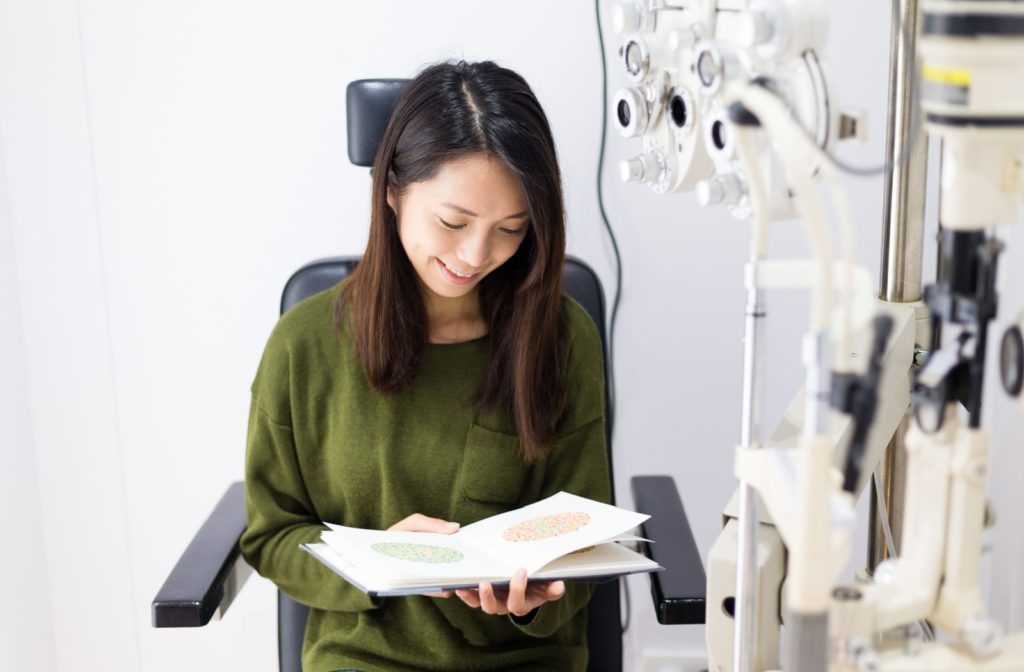Eye exams are an important part of taking care of your ocular health and should be regularly booked based on your age and other contributing factors.
A typical eye exam can range in time, taking anywhere from 30 to 60 minutes based on the tests and questions your optometrist may be performing.
Annual eye exams can help you maintain comfortable, clear vision, manage refractive errors, and detect or prevent eye diseases and conditions that can develop with age.
How Long Is an Eye Exam?
An eye exam will often range in time due to personal needs and the decisions of your optometrist. For example, if it’s your first visit with an optometrist, they may spend more time discussing your family’s medical history and any underlying health concerns you might be experiencing, which could result in a longer exam.
An optometrist with a good understanding of your medical history may require less time to cover those topics during the exam. With that in mind, a typical eye exam may range from 30 to 60 minutes.
How to Prepare for an Eye Exam
Here are some tips to prepare for your eye exam and potentially cut down on the time it takes to be completed:
- Bring your ID and insurance information to the appointment
- Write down any ocular symptoms you may be experiencing
- Take note of any medications that you’re taking
- Bring notes about your family medical history and any eye-related problems
- Bring your existing glasses or contact lenses
When Should You Get an Eye Exam?
The Canadian Association of Optometry offers some helpful guidelines on how often you should have your eyes checked, depending on your age.
Infants & Toddlers (Under 2)
Infants and toddlers may start to show signs of conditions like amblyopia, otherwise referred to as lazy eye. It is recommended that they have their first eye exam between 6 and 9 months to check for this condition and evaluate their overall eye health.
Preschool Children (2 to 5)
Preschool children are recommended to have at least one examination between the ages of 2 and 5. Refractive errors and other issues may be developing at this point, and it’s important to detect them early to set kids up for success.
School-Aged Children (6 to 19)
School-aged children should have consistent eye exams annually to check up on visual abnormalities that may be developing. If you notice signs of headaches, difficulties seeing, or sensitivity to light, it is important to book an appointment with your optometrist.
Adults
Regular eye exams can help make sure that vision problems don’t go unnoticed. Adults aged 20 to 64 should get an eye exam every 12 to 24 months. Your optometrist may recommend you have exams more frequently based on your visual health.
Seniors
Older adults may start to see a decrease in their vision as they age, and it is important to check in regularly with your optometrist. It is advised that you get an exam annually after age 65.
In some cases, your optometrist may recommend getting an eye exam more frequently, depending on your ocular health or underlying health issues that could eventually pose an issue for your sight.

What to Expect at an Eye Exam
During an eye exam, your optometrist will spend some time performing various tests that evaluate your vision and ocular health. Here are a few of the standard tests you might encounter:
Colour Blindness Test
During a colour deficiency test, your optometrist will likely ask that you look at different coloured plates with dotted and coloured numbers hidden within them. If you can identify and name the numbers or letters, you are likely not colour blind.
Visual Acuity
Visual acuity tests are performed to measure the overall clarity of your vision in each eye. A visual acuity test may include reading a chart from different distances with numbers and letters you are asked to identify.
Refraction
Refraction tests are commonly performed to identify refractive issues. This test can help to identify the lens power needed for your prescription. A typical refraction test may use a phoropter to place different lenses before your eyes, determining which ones help provide clearer vision.
Slit-Lamp Test
A slit-lamp test uses a tool that allows your optometrist to observe parts of your eyes 3-dimensionally and magnified. In doing so, they can look for abnormalities or issues that could become an issue.
Keratometry
Keratometry tests are performed to measure the curvature of your eye and look for potential abnormalities. They can help identify astigmatism and its location in relation to your eye.
Book an Eye Exam Today
At Red Deer Eye Care, our team of experienced optometrists can evaluate your ocular health, update your prescription, and look for early signs of visual conditions and diseases that may be present. Book your appointment online today at any of our three convenient locations!



